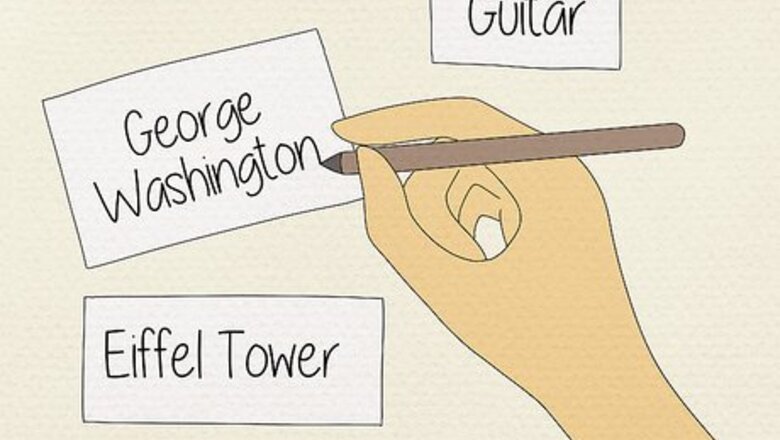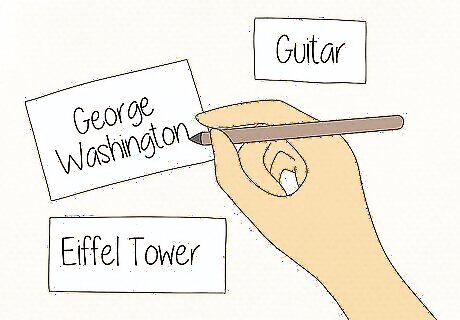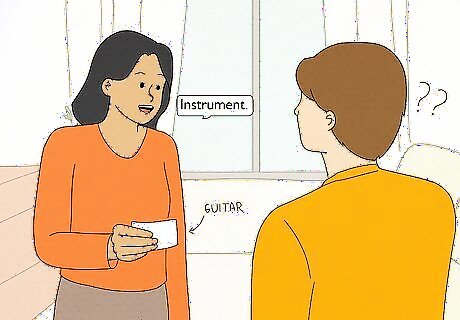
views
Game Setup

Ask each player to write down a person, place, or thing on 3 slips of paper. Give each player 3 small slips of paper. Players write down a person, place, or thing on each slip. These can be famous people, foods, movies, classroom vocab—anything at all! That said, encourage players to write down things that anyone in the room might be able to guess. For example players, might write down things like, “A guitar,” “George Washington,” or, “the Eiffel Tower.”

Place the slips of paper in a bowl and mix them together. Fold the slips of paper in half so that they can’t be easily read, then place them all together in a bowl. Then, give them a good mix with your hands to scramble them up. This is your salad bowl.

Split into 2 teams of 3-6 players and choose which will go first. Salad Bowl is a team game, so divide players into 2 teams, with an equal number of players on either team, if possible. If you have more than 12 players, consider running 2 games at once, or split into 3 equal teams. Then, flip a coin to see which team goes first. About 6-12 players is the sweet spot that ensures everyone can participate and be heard, but you might choose to play with more. To easily split into teams, count off the players “1, 2, 1, 2,” assigning players to team 1 or team 2, alternating.
Playing Each Round

Use verbal clues and say anything but the answer in round 1. The first team nominates a player to select a strip of paper from the salad bowl at random. Start a timer for 1 minute. The player then tries to get their team to guess what’s written on the paper by saying anything except the answer itself. When their team guesses correctly, the player grabs another slip and repeats the process, continuing until the timer goes off. Each team keeps track of how many answers they get right—each correct guess is one point. Total these points up to get the final scores at the end of the game. After, the second team sends a player to do the same, giving as many clues for as many slips of paper as they can in 60 seconds. If the player accidentally says the answer itself, they put the slip of paper back into the salad bowl and move on to the next slip. For example, if the paper says, “A guitar,” the player might give the clue, “An instrument with strings that can be electric or acoustic.”

Give a single word as the hint in round 2. Round 2 is known as the “password” round. For round 2 place all the slips of paper back into the bowl. Then, each team picks a different player to give the clues. In round 2, players can only say a single word per slip of paper, and it can’t be the answer itself. Give each team 1 minute to guess as many answers as they can. It’s important to pay attention in round 1, since the answers come back in both round 2 and round 3. For example, if a player draws “A guitar” in round 2, their clue might be, “instrument.” This is similar to playing a game of Taboo.

Play Charades to help your team guess the answer in round 3. As before, return all the slips of paper to the bowl and have each team nominate a player to give the clues. This time, the players can only act out the answers using Charades, and can’t use any words at all. Each team has 60 seconds to guess as many answers as possible. If the clue-giver accidentally says anything, they place the slip of paper back into the salad bowl. To give a clue for “a guitar” in round 3, a player might mime strumming or playing a guitar.

The team who guessed the most answers correctly after 3 rounds wins. As you play, keep track of how many clues each team has guessed correctly. After both teams have taken a turn in round 3, the team with more points wins the game of Salad Bowl. Write down more answers, add them to the bowl, and play again!
Keeping the Game Fun

Skip a slip of paper if your team can’t guess it quickly. If you’re giving the clues and your team is taking a bit too long to guess the answer, feel free to place the slip of paper back into the bowl and start giving clues for another. Sometimes it’s better to cut your losses and take advantage of the time you have left.

Give each player a chance to give the clues to their team. Send a different player to the salad bowl each round to give everyone a chance to give the clues. Also, play as many rounds as it takes to give everyone a turn at the salad bowl. This usually happens naturally, but you might want to write down more answers and add them to the salad bowl, then start from round 1 if any player has had a turn.

Play extra rounds with bonus rules for a longer game. To keep the game going, play extra rounds with extra rules. For example, round 4 might require teams to guess the answers with just sound effects, and round 5 might have the clue giver playing charades under a sheet or blanket. Come up with your own rules—the wackier, the better! Play a sixth round where players have to play Charades after being spun around 10 times to make them dizzy, or where players have to write their clues out backwards on a whiteboard.
















Comments
0 comment